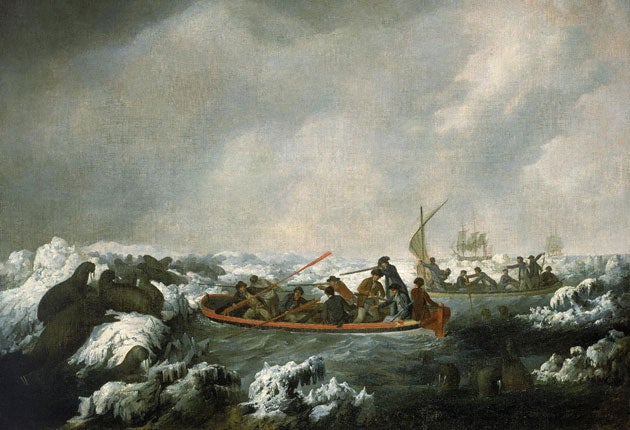North-West Passage: An Arctic Obsession, National Maritime Museum, London

Sound sets the scene. When you pass through the doors, you are assailed by the bone-chilling noise of howling winds, and the crepitation of ice. Welcome to an exhibition about the fabled North-West Passage, a source of endless, greed-driven fascination, and often fruitless and tragic endeavour, for centuries. Was it somehow possible to travel by sea from the North Atlantic to the North Pacific, passing through the ice-bound waters of Alaska? Many tried. Many perished. John Cabot, sailing in 1497, believed that it would give him access to the fabled riches of the Far East. There then followed five hundred years of failure. Yes, it was not until 1906 that a Norwegian called Roald Amundsen achieved the near impossible, threading his way through, quite modestly, in a small herring boat.
This pleasing, intelligent, compact show at the National Maritime Museum in Greenwich – and what more fitting a location could there be than this museum? – tells the story of some of the most remarkable of those voyages, and of those who led them. But it does much more than that. It shows us the instruments that were used, and of how they grew in sophistication, the food that was eaten, the clothes that were worn, and the way that these lands, and the indigenous peoples of these lands, were represented.
Early attempts to map the region were primitive in the extreme. Mercator's of 1620 shows the North Pole as a large rock rising from the sea. Sir Martin Frobisher's early voyages to the Arctic of 1576-8 resulted in a remarkable find – fool's gold, which Elizabeth I took for the real thing, locking it away in the Tower for safe keeping. Fragments of it are here. Other bits of it were later used as building material, and can still be found in Dartford, embedded in a wall near the railway station. Out of the discovery of the local wildlife, useful things emerged. Here, for example is a Royal Naval cocked hat, made out of beaver felt. Hunting in these regions became a popular sport. John Webber's dramatic painting of 1778, documenting an incident from Captain Cook's third voyage, shows a party of sailors shooting walruses, popularly known as "sea-horses".
As with all exhibitions of this kind, it is not the large-scale and often loftily idealised portraits of naval heroes that have the most effect upon you. It is the smaller, everyday things that testify to the terrible lives that those who did most of the work on board ship were obliged to suffer. Take this fragment of ship's biscuit, a solid looking brown disc, for example. Many a poor sailor's tooth must have come to grief on such a thing as this. Or, worse still, this old tin of pemmican, a kind of primitive dried and powdered meat product, mixed with fat. It looks as lip-smackingly appetising as a sliver of slate chipped from your local quarry. Well, perhaps I'm being too hard on it. It is, after all, almost 140 years old. Perhaps it was indeed mouthwatering when the breakers were pounding at your back and you'd had nothing else for 20 hours, and especially when washed down with a mug of rum.
The most sobering aspect of the show is the last room, which deals with now – and the aftermath of now. The melting of the sea ice. In the summer of 2007, the North-West Passage was entirely free of ice for the first time since records began. By 2030, the entire region could be ice-free. Then would come the scramble for the precious oil and gas reserves, the disruption of an ancient way of life, the disappearance of the local fauna, and the final destruction of this pitiless landscape.
Man, in all his boundless cleverness, would have had his revenge.
Until 3 January (020-8858 4422; www.nmm.ac.uk)
Join our commenting forum
Join thought-provoking conversations, follow other Independent readers and see their replies
Comments